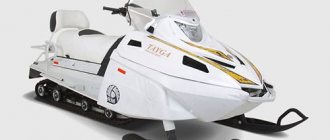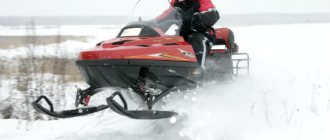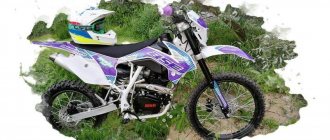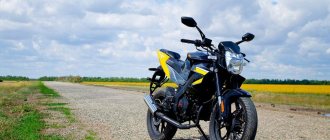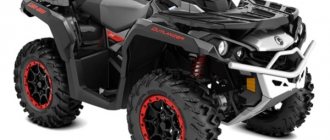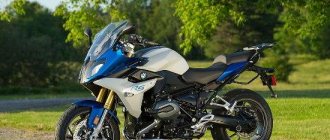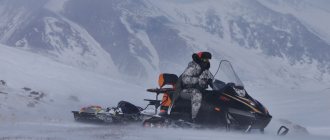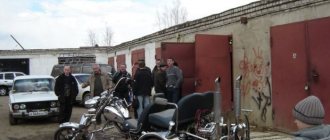The RMZ 550 power unit is produced by RM Detail LLC, a subsidiary of Russian Mechanics JSC. This power unit consists of a two-stroke engine and a gearbox (variator). Designed to equip domestic Taiga snowmobiles produced by Russian Mechanics JSC.
The RMZ 550 two-stroke engine used on domestically produced snowmobiles under the Taiga brand combines high reliability and ease of repair. During major repairs, cylinders can be bored to the nearest repair dimensions, and commercially available parts and ass. CPG and ShPG units according to groups of repair sizes make repairs cheaper. I will provide information about the most possible weak points and shortcomings of the motor that one encounters when operating Taiga snowmobiles.
Oil
Lukoil 2t is not for snowfields, have mercy on the equipment. Is the dealer really not carrying Taiga 2t semi-synthetic oil or Ekoil? Well, or Motul from foreign cars, people drive. Run-in 1:25. 1:20 is a lot, this is not Buran. After running in 1:40, 1:35 in cold weather and under load. Lukoil 2t for Soviet motorcycles and boat engines, you can also use Buran, its other name is MGD-14, it’s a mineral water with God knows what additives. Lukoil is NOT SNOWMOBILE oil.
But still, where can I get the “+” and “-” sensors under the hood, please tell me, otherwise they write that you can’t change the variable time, you have to take a constant one, I’m at a dead end. So install the cheapest battery, charging relay (our price is 1700 ), and then power all additional equipment from the battery, starting with temperature sensors and ending with the cigarette lighter socket.
From various sources, as I understand it, the Varyag 500 is built on the basis of the old Taiga, as if taking into account the jambs.
The declared appetite is 22-25 liters per 100 km, depending on the snow cover it can be 60, almost the same as that of the Taiga Patrol 550. But the powerful Yamaha nitro snowmobile eats less - 15-20 liters.
There are holes for the starter. The crown must also be placed.
The compression in the cylinders for the Varyag 500 should be 9.6 atm. the norm for air.
the best spark plugs NGK BR9ES made in Japan, A 20 D.
set the belt on the varik to 35
Taiga. Advantages and disadvantages. Owner reviews
Have you decided to order a Taiga snowmobile for yourself? Therefore, you, in fact, like almost every new snowmobile user, are eager to find out about their operation from the owners themselves, that is, as they say, “first-hand.” However, most suppliers of snowmobile equipment mainly sell it, but do not use it themselves. The employees of our company decided to take and post comments from snowmobile sites; we immediately apologize to our readers. Terminology and spelling have been preserved entirely. And if you carefully read what is written below, and this was written precisely by the owners of the equipment, you will never come across the lines: “Don’t buy Buran or Taiga and don’t buy Lynx.” The decision whether to make a purchase or not is made by each person personally, guided by his own goals and requirements for using the technology. Some may have the goal of “taking you from position A to position B,” others may have the goal of climbing further into the tundra for a few evenings with friends and returning home with game, others may have the goal of climbing the mountains only on a special mountain snowmobile, since on another don't do this, and so on...
Based on materials from the forum talk.gans.ru
Three seasons on the Taiga 5th configuration. Satisfied in many ways. Consumption is 30-35 per hundred. Passability is satisfactory. It crushes small things up to 5 cm in diameter easily. A winch under the seat, a 30-meter rope and an ax are mandatory attributes. “Slusa” - not afraid of water with snow or ice with water. I say kind words to her and she goes.
I drove around the stream - flew up a steep slope - stopped - below I see a talik without snow, I thought to myself “I’ll go and get stuck” and that’s what happened!!! It's January 4th! There is no winter now either. Unscrew - no options. I took out a winch, hooked it to the fork and a birch tree from behind - half a meter back - and full speed ahead. Anything can happen. But “Taiga” moves very well, both through the forest and other terrain. A bump stop in front is required. Do you know how they cook on all-terrain vehicles!!!
The picture clearly shows Taiga’s “landing” (the entire weight of the snowmobile is concentrated only on the skis) - in deep snow she sits down and sticks with the entire plane of the bottom under the engine, and in order to get out she has to not only trample, but often also turn the snowmobile around with her hands. track. While the main weight of the Buran falls on the goosenecks that extend far under the engine, and even in case of landing, it is enough to just trample and leave with a rocking motion. I am not against two-ski snowmobiles for acceptable regions, but I myself prefer Buran (when I want to spend the night in the warmth).
I already have 2500 km in Taiga. I carry it from Moscow to the north of the Vologda region. I’m driving there alone with a friend through the swamps. Whatever happens, you have to leave it there. A snowmobile, only for a huntsman, which is at least 30-40 km if it works for him. I made a richer mixture from the new one (one carb. needle on the 2nd groove at the bottom + a mixture (more oil 1:40) while driving. Naturally, everything that it won’t go without (if possible) is under the seat. There are a lot of little things over several years I had to replace it, but I was lucky - not for hunting (on rides at the dacha). I go there for hunting a year, at best, a couple of times. Taking a foreign car, of course, is great, but the toad is choking to throw away 2 hundred. It seems like Taiga is enough for now with all the nuances .
It drags two people through loose snow, consumption is 20 liters per 75 km (approximately).
The risk of returning on skis (but so far God has been merciful).
I'll get involved. Just last weekend there was a test drive with the participation of Taiga, Yamaha Bravo and Yamaha Viking. All just after running in. Having filled full tanks of gasoline from the nearest gas station, my son-in-law and matchmaker, full of pleasant expectations, went light into the forest. After 200 meters the Bravo stalled. After an hour of resuscitation measures, without understanding the reason, he drained everything into the ignition and was dragged by Taiga to the house. At this time, the Viking also stalled, and without further ado, Taiga also returned home. The reason is simple - the gasoline seemed to be mixed with water. After connecting obviously normal gasoline to the canister, everything worked. After draining (not on the ground) the tanks and refueling with fresh ones, after a little fiddling, the Yamahas started working. I didn’t change gas in Taiga. Naturally, to be confident in the technique for the next day off, we rode a little. This is my first time on all three.
Feelings IMHO: On the Bravo it’s like on a moped, the seating position is not very comfortable, it’s low. It doesn't go more than 60. But on the loose snow, despite his son-in-law’s decent build, he felt more confident than others - a light snowmobile. The lack of reverse gear is not a big problem; you can turn it around with your hands. But it costs less than Taiga.
Viking - I didn’t like the high seating position - it wobbles, I didn’t like that it’s not faster than the Taiga type 80, I didn’t like that if you get stuck on it, you won’t be able to get out on your own. After that, I began to like my Taiga (regular, with a starter and one carburetor, without separate oil supply) even more. Not a bad pirate copy of Ski-do. I won’t say anything about hunting in the taiga, but for driving around the city, Taiga (if you don’t have money for the original) is quite a worthy choice.
Taiga, compared to Buran, is a storehouse of shortcomings. If you want, I can list:
- A less high-torque engine (compare the piston group), as a result of which you always drive at high speeds, threatening overheating.
- Nightmarish adjustments.
- The layout (location and body kit) of the engine is even more terrible, making it a problem to even replace the CVT belt (there is simply no room), not to mention adjusting the carburetors while the engine is running (option with two Mikunis).
- Inability to use a blowtorch when starting the engine at temperatures below -40 (too much plastic and rubber bands).
- It moves very poorly on slopes, when climbing along valleys, it constantly drifts, it is more difficult to level since the support on 3 points makes it more stable, and it is more difficult to tilt it.
- The load is pulled worse.
- Not omnivorous.
- The glass hardly covers it.
- The open chassis often catches sticks in the forest, but on ice it is better than the closed Buranovskaya, this is a plus for it.
- When refueling in the wind, the seat is often filled with gasoline.
- During the first trips, the steering wheel heaters burned out, the rear mudguard was broken because it always gets into the track when reversing in deep snow, the tip of the spark plug was broken, the factory tow bar was broken. in the taiga, in the first 500 km, I sharpened the earring on a sled.
- Greater width (requires wider roads compared to Buran).
- Quite a high price.
Here is an approximate list of shortcomings that makes the operation of Taiga problematic in the conditions of southern Yakutia. Buran is capable of transporting its owner even on one right cylinder, and on one track it is still capable of moving.
Let's object:
- Interesting conclusion. Isn’t it fate to turn on the reduced option in the extreme? And only those with crooked hands get warm. And in general, instruments exist to indicate temperature.
- There are definitely no more nightmares than Buranov’s
- Don't make people laugh. If you don’t know, then you don’t need to write all this nonsense. The adjustments are great. Belt replacement 1 minute.
- I haven't used it, I don't know.
- It all depends on the gasket between the steering wheel and the seat.
- It’s debatable, and even a reduced one exists.
- Perhaps this is relevant in the deaf.
- I would like it to be a little more painful, but it’s ok
- What does open mean? Does the drill have protective covers? My operation is forestry and all sorts of branches are not collected in the goose, or see point number 6.
- This is a very relevant question
- The towbar is used according to the instructions and not according to needs - then there will be happiness. There is a number on the mudguard and it has never been bent or twisted. The rest are consumables and are not worth paying attention to.
- The taiga is so wide that there are not enough clearings; he drives through the forest among the fir trees with a bang. It may be a few centimeters wider, but the controllability is much better than that of an iron.
- The difference in price within such limits is actual Buran 120,000 Taiga 140,000.
- In general, out of all of the above, the whole world is a sucker, and that’s why they ride on the system of 1 goose, 2 skis, and I’m smart.
Hi guys! “An idiot’s dream has come true.” After talking in the thread “I want to go hunting on a snowmobile” and reading “Snowmobile on a hunt” I BOUGHT it! Taiga 5th configuration. Here it costs 209,000, I negotiated with the dealer for 200,000, but they charged 1,500 for delivery to the village 60 km away. I went for a ride that same day. It was -5 outside, great! First, I drove along the village streets to understand how this vehicle behaves. Then to a warm garage. I tried tightening bolts, nuts, electrical connectors, connecting pipes and hoses. Almost everything seems to be new. Back on the street. I left the gardens in real snow. Again I tried how it steers and drives. After driving around the clearing, I began to approach drifts of looser snow. I don’t try to give in during the run-in, I dug in twice just because I didn’t want to. I trampled and left. I realized that the car loves playfulness then and goes playfully. I didn’t like the taxiing, it was very specific, but you can adapt, it’s already working. I remembered about the ski pads, I’ll take them; if it’s loose, I’ll either have to tumble it in or make sure the face doesn’t sink in so much. Second day. After all, the snowmobile spent the night in a warm garage (there are also such in the village). In the morning I went in a (passenger) car to get some gasoline and oil, and brought another 30 liters. On the street -29. In Siberia, such changes are par for the course. I took Taezhka out into the fresh air, warmed it up, turned it off, and let it sit for 2 hours. I tried to start it “by science” as it is written in the book. F... you! I understand that the engine is being run-in, has not gotten used to it, there is gasoline with an abundance of oil (I did not regret it and bought a good one). I just turned out the spark plugs, spun them with the spark plugs on the ground, warmed up the spark plugs and quickly turned them on. It growled from the starter with half a turn. Guys. It turns out I lied to you when I told you that at -30 I would watch hunting and fishing on TV. I went through the fields and ravines to my places. (it has already dropped to -32). It took half a day to ski there, but here I got there in 20 minutes and didn’t freeze a little, so. Rougeau didn’t take it, the goal was to learn how to ride a snowmobile. The statements about driving along the slope were justified. She’s a very stubborn little beast, but she can be forced. Here one ski would be better. But on the open field “SONG”, I didn’t accelerate it more than 50, but I’m still SATISFIED. On January 5 they promise -20. An experienced snowstorm guide invites you to hunt. I WILL GO.
Hi guys! Last weekend the weather (-25, -27) allowed us to go hunting on a snowmobile for the first time. From December 30 (the day of purchase) to January 17, I drove 210 km around the village at -25, -32 (I'm running it in). We hunted in a pine forest (if it can be called a forest). A continuous windfall of kushari and sogry. I mostly walked through the forest following the trail (in the taiga) of a snowstorm. I struggled through. And there is little driving experience and a snowstorm in the forest has a triple advantage in all indicators necessary for these conditions, as much has already been said above. I was convinced with my own eyes! It climbs like an iron and doesn’t fall, only bark flies from the trees “it’s iron.” My Taezhka (or I) will either fall over or get caught. They trailed the goats along the gullies. To be honest, the conditions are far from being suitable for running in; I spared the car as much as I could, but it still suffered. They dug it out, lifted it and began to squeeze it into a more open space. Here the trail riding (blizzard) ended and the main factor was the lack of driving skills and ignorance of the capabilities of the snowmobile. The snowstorm was confidently doing its job through the forest, and I was looking for ways to drive in the right direction. But as soon as the slightest “operational” space appeared, all the delights of the snowstorm became pale and useless. Howling hysterically as he struggled, he barely showed signs of increasing speed. Here, having slightly pressed the throttle, Taezhka easily reached the “glider”, the engine “sang its high note”, the suspension easily “played back”; snow sastrugi. Acceleration and speed decided everything, the herd became manageable on the ground. Of course, I didn’t have to shoot that day; I had other tasks. At the end of the day, “at the debriefing,” over a glass of tea, and over a barbecue, I naturally listened to all the “opinions and advice” about my “riding.” No offense, even for the two younger ones who have already killed more than one snowmobile, and after “tea” New (but painfully familiar) sensations in the joints, muscles of the back, arms, legs and everything else took over in my body. We’ll rest for a week and if it’s above -30 we’ll go back to the forest. It's -36 outside now. The taiga hasn't caused much trouble yet. The ignition switch and manual fuel pump were unscrewed. The rubber band on the ignition switch (which covers the mask from snow) freezes and does not allow the key to return on its own from the starter position. It looks like it was fired at the start for this reason, but so far it’s working fine. I pierced the windshield in the lower corner with a raised ski branch (sealed it). I bumped into a pine tree - I slightly dented the bumper, there is no point in fixing it, it needs to be made from a steel pipe.
I called a friend and asked him to send a brief chronology of the operation of his Taiga ST-500 D5 configuration. I quote his letter:
- Taiga-500, purchased on January 10, 2008. Price 176,000 rub.
- Mileage 600 km, CVT repair. CVT weights 1200 rubles + labor 1000 rubles = 2200 rubles.
- Mileage 750 km, replacement of the transmission driven pulley 5000 rubles + labor 500 rubles = 5500 rubles.
- Mileage 1200 km, piston replacement. Piston made in Austria 3500*2 + 1000 rings + labor 6000 rubles + 500 rubles gaskets = 14500 rubles.
- Mileage 1950 km, failure of the oil pump as a result of a complete drain. engine repair. Two cylinders 6000 rubles + piston 2 pcs 7000 rubles + rings 1000 + crankshaft 4000 rubles + oil seals, bearings, gaskets 2000 rubles + labor 8000 rubles = 28000 rubles.
- Mileage 1950 km. Conversion to one carburetor. Mikuni carburetor (Japan) diffuser for 32 5000 rubles + intake manifold 1200 rubles + carburetor muffler 1500 rubles + did the work myself = 7700 rubles.
- Various small things were also purchased and repaired: a tank cap (often breaks), a tee for fuel, a hand pump wire (replaced with a metal one, it stood in the field for half a day because of such a small thing), a throttle cable, a throttle handle, the heated grips failed, reinforcement of the seat body ( inside it is plastic and is pressed through).
- Mileage 2300 km. With great difficulty, sold on December 20, 2009 for 120,000 rubles.
Sincerely, your friend Volodya.
I'm asking for advice. Which “Taiga” is better to choose for hunting? I myself am inclined towards the Patrol model with a 60 cm gooseneck, but there is also a new model Taiga Patrol 550 SWT. Which configuration will be more reliable?
Yamaha Viking 540
She's worth other people's money, so for now we're talking about Taiga.
Foreigners are good, but expensive. I myself struggled with the choice for 2 months. I picked up a TAIGA of the fifth configuration on January 30th. Already run it in. So far I'm happy. I threw out the original spark plugs, installed “hot” ones, and started starting at -32. I put wide pads on the skis, now the powder is a song. But in the forest the snowstorm goes better. “Like a collective farm gelding in the village.” (For now) I think that there is no point in hunting with more power and speed, but if only we could be more confident in the reliability of our equipment.
Thank you! We'll keep thinking. I would also really like to hear the opinions of users and compare Buran ADE with Taiga in terms of reliability?
You're welcome, Sergei. On the first model, Taigi drove about 9 thousand km, mainly in the taiga, lowlands, littered with fallen trees. I go where I feel sorry for expensive equipment. I had to travel with hunters to Burany more than once, living in huts. More than once I carried elk meat on sleds to the hut in one trip. Everyone unanimously says that Taiga is better than Buran, not to mention the fact that on Buran you need to ride standing all the time, only alone and without heating. I covered up to 180 km at one gas station, it all depends on driving conditions.
There can be two ambushes:
- Don't kill Taiga in the first season. It is not necessary, without sufficient skills, to climb into the thicket and jump over dead trees blindly, because... You can cut the caterpillar by the sharp edges of broken branches. They are not visible under the snow, although when collided with they can appear as knives. This is how I ruined the caterpillar in the first season. Stop, check with your foot under the snow, if there is any, cut it off and move on. At first everything happened - it burrowed, drowned, fell on its side, then it went away like a bad dream, although the places were the same.
- I bought one of the first models with one carburetor and this is only a plus. For friends with two things go worse, because... setting them up equally is very difficult. One cylinder breaks as hard as it can, overheats, and the second cylinder sags. I know modifications for one carburetor.
Still, they constantly talk about the cool quality of Buran - maintainability. Only they are silent about where this maintainability comes from and how much money is spent on maintaining this wonderful quality of Buran.
Those who have the opportunity to change Buran to Taiga do so without hesitation. Those who do not have such an opportunity either wait for it to appear, or say that there is nothing better than Buran in the whole wide world. This is similar to songs about an easy Bravo hand turn without reverse speed, especially in the forest, and even with chest-deep snow. They even promised to post photos of this action. Only there are no photos, just as there are no enthusiastic responses from Buranov owners who were convinced to buy it. Of course, if you have the opportunity to take a foreign car and don’t mind ruining it in the taiga, then this is the best option. Our equipment is ours and buying it can be like buying a pig in a poke. By the way, instead of a winch, an ordinary, not thick halyard can help out. A couple of turns around the nearest tree and the snowmobile's protective bracket. Between the threads there is a stick, and screw forward. At least it will help you get it out of the hole.
Hi guys! I see a couple of new pages appeared while I was out hunting. I think it's pointless to argue. There are Buranists, Taigists, Vikingists, etc. Comparing domestic equipment and imported equipment is generally blasphemy (it’s an insult to the fatherland), and a fool understands this. This is my first season going hunting on a snowmobile. I took it on 12/30/09 (Taiga 5 configuration). As of January 30, 2010, the mileage was 450 km. Every ten kilometers I learn something new about snowmobiles while hunting. Our frosts this month ranged from 25 to 47. I didn’t get it above 32. At 30 it started to start after replacing the spark plugs with “hotter” ones. During the break-in period, I adjusted the carburetors (with the running-in, the idle speed increased). After the break-in, the heads were tightened a little, the gooseneck was tightened a little, some minor details - (factory negligence) fastening the ignition switch, fastening the boost pump, fastening the headlight. Otherwise, there seem to be no complaints about the plant (Rybinsk) (yet). I expected the worst. Separate lubrication, judging by the oil and gasoline consumption, operates in passport mode. During the run-in, I mixed fuel with oil 30:1 at the beginning and 50:1 at the end of the run-in. The cold one naturally smoked a lot, but in such frosts it is better to be on the safe side. After the break-in, I still don’t think about giving up gasoline and oil, although the manufacturer advises adding only 1%, I dilute it 100:2 (2%). Yes, when checking, the density of the electrolyte in the battery was 1.19, brought to 1.27. Now you won’t have to defrost it, but you still have to start it manually in the cold. I don’t think it’s advisable to increase the density higher to the detriment of the resource. Once I went hunting with an “experienced snowstorm guide.” Did not like. Not my style of hunting. I rely more on intelligence and knowledge of the habits of the game rather than on “technical” superiority over the animal. We ride one snowmobile together + skis and one gun. I know, it’s risky, but there are populated areas within a radius of 15-20 km everywhere (where I hunt), and there’s cellular coverage in half the territory. There is a lot of snow, loose. I installed wide pads and that’s a song. It’s a bit difficult for two people to walk through the forest, but it’s also easier to “trample” with two people. But he eats a bastard!!! Yesterday I burned 40 liters over 80 km. AND PLEASURE IS MORE EXPENSIVE.
Personally, after much deliberation, I will take the Taiga Patrol 550 SWT. I read the opinions, most recommend Yamaha and other Western snowfields. But taking new imports - for 330-350 thousand rubles and more - is somehow unaffordable. Used bourgeoisies also do not inspire confidence (who and how the owner drove it), these are not used cars, I mean imports, after all, the service life of snowmobiles is not comparable to a car. I called Russian mechanics several times and they said that this model is not much inferior and not at all inferior to its Western counterparts, so God forbid, I want to believe. Please don’t criticize me, I’m still a newbie and I hope the Taiga Patrol 550 SWT will live up to my hopes.
Technique for adjusting ski toe
- check that the steering wheel is straight
- loosen locknuts 15 of both steering rods 20, 27
- by rotating the steering rods, ensure that when the skis are positioned “straight forward”, distance A in the front of the skis is greater than distance B in the rear of the skis by 10 mm (A – B = 10 mm)
- tighten the tie rod locknuts.
Taiga tormented me, only I unlocked the gearbox, now it started working on either 1 or 2 cylinders, i.e. at idle it doesn’t work normally at all, but when driving it runs on 1 cylinder, then on two, and so on in a cycle, then 1 then 2, with the throttle equally pressed, TAIGA500 1 carb. It was the same with mine, I came home on a rope. Knowledgeable people from the site helped. The hall sensor was replaced and the order was correct.
How the Taiga snowmobile appeared
The history of the appearance of Soviet snowmobiles began in 1974. At that time, an aircraft manufacturing military plant was operating in the city of Rybinsk, which, by order of the ministry, was required to develop the production of goods for people in addition to what it did for the military industry. The choice of plant director Dergunov fell on snowmobiles.
Having received the order, the plant's design bureau began work. As a result, a new snowmobile was born. We all know it - this is the Buran snowmobile. It had a slightly unusual layout for those years - two driving tracks and one control ski. This technique has undergone numerous tests. Even those cars that were produced at the beginning still served until the very end of the USSR and after.
But the years passed, technology changed, the market changed. The new market economy brought us foreign snowmobiles, which, although they were not as reliable and repairable as the Buran, were distinguished by their high-speed qualities. Foreign cars had a little less maneuverability; they could not overcome loose snow with such confidence, walk calmly through forest thickets, snowdrifts, and overcome covered trees and stones.
Their only ski was well sprung, which gave good acceleration and riding comfort. So that it would be important for wealthy people, accustomed to the conveniences, whose trust everyone who produced goods in the 90s sought to win. So in 1997, 23 years after the start of snowmobile production, a new snowmobile, “Taiga,” was released at the Russian Mechanics enterprise in Rybinsk.
The Taiga differed from the previous model, which had gone through fire, water and copper pipes, with a well-sprung track, relative traction power and the ability to travel at high speeds. If previously a necessary accessory was a snowmobile sled, the Taiga was initially designed to overcome the snowy expanses without them.
Of course, on such a snowmobile you cannot bring firewood or the carcass of a killed elk from the forest, nor can you go pick up a barrel of diesel fuel for the village power plant. But what Russian doesn’t like to drive fast, as the classic said! It’s dangerous, but nothing compares to the splashes of snow scattering on the sides and quickly flying kilometers from the side. Even modern Burans began to be made according to this scheme.
Technical characteristics and adjustment data
Engine RMZ-500 Weight – 37 kg. Dimensions (length x width x height) in cm approximately: 50x50x40.
Number of cylinders – 2 Cylinder diameter, mm – 72.0 Piston stroke, mm – 61.0 Cylinder volume, cm3 – 496.7 Compression ratio (geometer) – 10 Max engine speed (+- 100) – 6500/6800(2- x carb) Technical characteristics and adjustment data Gap at the joint of the piston rings, mm - 0.2 (new), -1.0 (wear limit) Gap of the piston/ring groove, mm - 0.03 (new), - 0.2 (wear limit) Gap between the piston and cylinder, mm - 0.08 (new), - 0.4 (wear limit) Gap at the end of the connecting rod, mm - 0.2 (new), - 0.7 (wear limit) Axial crankshaft play, mm — 0.3 Max crankshaft journal runout, mm — 0.08 Generator power, W — 120 (RZP) / 200 (Ducati) Ignition — BSZ (thyristor) Spark plug — NGK BR9ES Spark plug gap, mm — 0 .45 Ignition synchronization, mm — 1.66 Sensor coil, Ohm — 3.5–4.5 Charging coil, Ohm — 550-660 Lighting coil, Ohm — 0.12-0.15 High/voltage transformer, Ohm — 0.5-0.6 (primary), - 4-5 kOhm (secondary) Carburetor - Mikuni - VM-32 (1 carbure) / 2x VM-34 (2 carbure) Main fuel. jet (GTZ) – 250 (VM32) / 210 (VM34) Sprayer – 159 0-0 Jet cold. stroke - 25 Symbol. needle - clamp position - 6DH8-4 Float position adjustment - -1mm - 23.9 Mixture quality adjustment screw -1/16 rpm - 1.5 Cold speed. stroke, rpm - 1600-1750 Gasoline type/octane number - AI-92 Oil/fuel mixture - 1:40 Oil injection system - E11 Fan belt deflection at a force of 5 kg - 8-9mm
Spark plugs for snowmen “Taiga” with Russian ignition NGK 9ES for snowmen with “Ducati” NGK BR9ES also DENSO W27ESRU If you want not to spend money on CVT belts multiple times, buy branded BRP, they have no competitors in terms of quality yet.
Place for starter
Increasing ground clearance
Spacers to increase ground clearance
Increased ground clearance on Taiga Varyag 500

